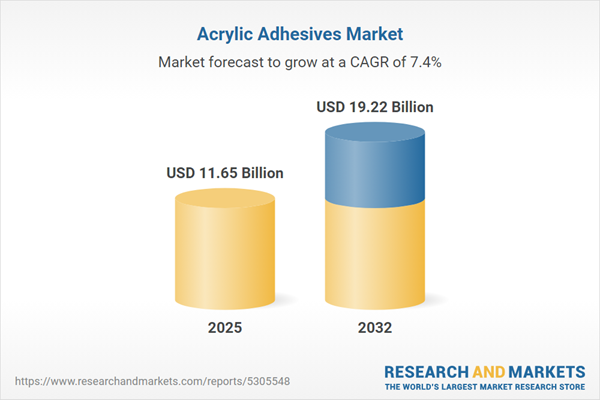Speak directly to the analyst to clarify any post sales queries you may have.
The acrylic adhesives market is at a pivotal point, driven by technological progress, regulatory changes, and a strong emphasis on sustainability. Companies seeking effective bonding solutions in increasingly complex and sensitive applications find acrylic adhesives well-positioned to support evolving operational requirements and innovation goals.
Market Snapshot: Acrylic Adhesives Market Growth and Outlook
The Acrylic Adhesives Market grew from USD 10.83 billion in 2024 to USD 11.65 billion in 2025. It is expected to continue growing at a CAGR of 7.43%, reaching USD 19.22 billion by 2032. This expansion is underpinned by robust demand from automotive assembly, construction, electronics, medical devices, and packaging sectors. Performance criteria such as rapid curing, chemical resistance, and durability increasingly drive adoption in these industries. Ongoing material innovations and responsive strategies to supply chain fluctuations position acrylic adhesives as a central technology in next-generation manufacturing.
Scope & Segmentation
This comprehensive research covers strategic developments, segment trends, and geographic dynamics for a nuanced view of the acrylic adhesives market. Major segmentation points include:
- Product Type: Hot melt (EVA based, Polyolefin based); Solvent based (High VOC, Low VOC); UV curable (Cationic, Radical); Water based (Anionic, Nonionic)
- Application: Automotive (Exterior, Interior); Construction (Flooring, Panels & Insulation); Electronics & Electrical; Labels & Tapes (Adhesive Tapes, Pressure Sensitive Labels); Medical; Packaging (Corrugated Packaging, Flexible Packaging)
- End Use Industry: Building & Construction, Electronics & Electrical, Furniture & Woodworking, Medical, Packaging & Labeling, Transportation
- Form: Liquid, Paste, Solid
- Cure Type: Heat curing, Moisture curing, UV curing
- Distribution Channel: Offline, Online
- Regions: Americas (North America: United States, Canada, Mexico; Latin America: Brazil, Argentina, Chile, Colombia, Peru); Europe, Middle East & Africa (United Kingdom, Germany, France, Russia, Italy, Spain, Netherlands, Sweden, Poland, Switzerland, UAE, Saudi Arabia, Qatar, Turkey, Israel, South Africa, Nigeria, Egypt, Kenya); Asia-Pacific (China, India, Japan, Australia, South Korea, Indonesia, Thailand, Malaysia, Singapore, Taiwan)
- Key Companies: Henkel AG & Co. KGaA, 3M Company, Sika AG, Arkema S.A., H.B. Fuller Company, Illinois Tool Works Inc., Avery Dennison Corporation, The Dow Chemical Company, BASF SE, Parker-Hannifin Corporation
Key Takeaways for Senior Decision-Makers
- Advances in polymer science are enabling customized acrylic adhesive formulations, strengthening competitive differentiation and allowing tailored solutions for challenging substrates.
- Technology adoption is reshaped by digital manufacturing trends, integrating real-time monitoring and analytics to improve bond reliability and reduce operational waste.
- Regulatory and consumer preference for sustainable adhesives is accelerating market share gains for low-VOC and water-based alternatives, with supplier innovation focusing on compliance and reduced environmental impact.
- Strategic collaborations and joint ventures support localized production, secure access to raw materials, and accelerate product development cycles, particularly for emerging application areas.
- Mergers and acquisitions add depth to technology portfolios and strengthen geographic presence, supporting rapid response to shifting market demands.
- Tariff fluctuations are encouraging companies to realign sourcing, increase regional production capacity, and bolster supply chain resilience to maintain cost competitiveness.
Tariff Impact: Navigating Supply Chain Disruption
Recent United States tariffs have shifted raw material dynamics, compelling manufacturers to reevaluate sourcing strategies and focus on alternative suppliers or near-shoring options. These adjustments influence pricing along the value chain, especially in segments reliant on imported feedstocks. Forward-looking organizations are responding with lean manufacturing, process optimization, and strategic contracts to mitigate cost volatility and maintain customer confidence.
Methodology & Data Sources
The report combines secondary research—drawing from industry, regulatory, and technical literature—with primary interviews conducted with key manufacturers, users, and academic experts. Market modeling, SWOT, Porter’s Five Forces, PESTEL, and scenario analyses inform strategic recommendations. Validation includes peer review by senior analysts and triangulation against multiple data sources for reliability.
Why This Report Matters
- Delivers actionable insights to guide R&D investment, supplier negotiations, and market entry or expansion strategies.
- Equips executives with comprehensive segmentation and regional intelligence necessary for risk mitigation and targeted growth.
By understanding transformative technology trends and realigning supply chains, decision-makers can enhance competitiveness and achieve sustainable growth in a rapidly evolving market.
Conclusion
The acrylic adhesives market offers opportunities for operational optimization, material innovation, and strategic transformation. With ongoing advances in chemistry and manufacturing intelligence, stakeholders can make informed decisions that position their organizations for long-term success.
Additional Product Information:
- Purchase of this report includes 1 year online access with quarterly updates.
- This report can be updated on request. Please contact our Customer Experience team using the Ask a Question widget on our website.
Table of Contents
3. Executive Summary
4. Market Overview
7. Cumulative Impact of Artificial Intelligence 2025
Companies Mentioned
The companies profiled in this Acrylic Adhesives market report include:- Henkel AG & Co. KGaA
- 3M Company
- Sika AG
- Arkema S.A.
- H.B. Fuller Company
- Illinois Tool Works Inc.
- Avery Dennison Corporation
- The Dow Chemical Company
- BASF SE
- Parker-Hannifin Corporation
Table Information
| Report Attribute | Details |
|---|---|
| No. of Pages | 181 |
| Published | October 2025 |
| Forecast Period | 2025 - 2032 |
| Estimated Market Value ( USD | $ 11.65 Billion |
| Forecasted Market Value ( USD | $ 19.22 Billion |
| Compound Annual Growth Rate | 7.4% |
| Regions Covered | Global |
| No. of Companies Mentioned | 11 |









